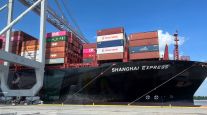Fleet Failures Increase in 4Q Despite Higher Freight Demand
This story appears in the Jan. 27 print edition of Transport Topics.
A new report said fleet failures rose to the highest level in more than three years during the fourth quarter, even though freight demand improved, reversing a long-standing trend.
Ongoing cost and regulatory pressures weighed on companies during the final three months of 2013, according to Avondale Partners analyst Donald Broughton, who made the report available to Transport Topics on Jan. 21.
A total of 335 fleets with 7,775 trucks failed during the fourth quarter, the highest since the third quarter of 2010 and more than double the 150 carriers and 2,515 trucks in the final quarter of 2012. Failures also rose from the 2013 third-quarter total of 235 carriers and 4,985 trucks.
The pace of failures has increased sequentially in each quarter of 2013, pulling 21,775 trucks off the road — topping the combined total for 2011 and 2012, the report said.
Broughton told TT that bankruptcies rose despite a fourth-quarter recovery in truckload freight, marking the first time this has happened in the two decades that he has compiled the report. In the past, he said, failures spiked when demand dropped and vice versa.
“In the past, we haven’t had a period where demand is growing and capacity is coming out of the industry at meaningful levels,” he said. “If that continues, it could be very powerful for pricing for truckload carriers.”
If demand and capacity trends continue, truckload pricing may rise later this year by “strong single digits,” he said, suggesting 6% to 8%.
That would be a sharp increase from the 1.8% pace shown for the past 12 months in his report.
“The last four quarters have seen an uptick in failures as we believe the combined headwinds of cost inflation outpacing rate increases, soft demand and ever greater competition from intermodal have taken their toll on many of the remaining marginal carriers,” the report said.
Failures were at all-time lows in those years, as owners of marginal carriers took advantage of high used-truck prices to sell out and avoid bankruptcy.
Recent announcements by Knight Transportation and Covenant Transportation Group that their earnings exceeded Wall Street expectations also underline favorable fourth-quarter freight and pricing.
Knight ranks No. 31 on the Transport Topics Top 100 For-Hire Carriers list, and Covenant is No. 41.
Another positive indicator was the stronger spot market measured by load board operator TransCore.
Analyst Benjamin Hartford of Robert W. Baird has more modest pricing expectations of 1% to 2% this year, matching 2013. Another analyst, John Larkin of Stifel Nicolaus, said in a report that there is “still not enough capacity reduction to support sizable rate increases.”
An improved pricing environment could become more evident in the “bid season” during the first four months of the year. That period is critical for fleets because about 70% of all contracts are negotiated then, Broughton said.
The truckload equipment cost picture also is changing.
“Over the past three years, we have generally seen continued high single-digit equipment cost inflation as trade cycles continued to bring in new equipment that was significantly more expensive than the pre-EPA 2010 equipment it replaced,” the report said.
Carriers that replenished fleets with new equipment in recent years should see cost pressures drop into the 3%-to-5% range in 2014, Broughton said, as their 2010 truck trade-ins fetch higher prices. However, maintenance costs will remain higher for fleets with older trucks.
In addition, he said, fleets with older units that haven’t yet added electronic logging devices in line with Federal Motor Carrier Safety Administration requirements face another challenge.
Those fleets will be under pressure to increase pay in order to keep drivers who won’t be able to run as many miles once the FMCSA requirement is met, Broughton said.
Broughton also emphasized a push toward continued pay increases.
“Expect the driver market to remain tight in 2014 and as such see continued upward pressure on carriers’ largest line item, driver pay,” his report said.
Wage increases in 2012 and 2013 “have brought wages back to more competitive levels relative to other industries,” Broughton said. “We see the recent stabilization of driver turnover as a sign that across the board pay increases are not necessary in the immediate future.
“Expect pay increases in 2014 to be more geared towards ‘gain sharing,’ ” the report said, referring to “bonus pay related to fuel economy, utilization, safety and service.”
Intermodal also continues to be an important factor in the truckload market, Broughton said.
As intermodal operators leverage their fuel-cost advantages to do more runs in the 600-mile range, other fleets are forced to do even shorter-haul runs, Broughton said. That effectively adds capacity in the shorter-haul markets because equipment is available faster than if it was making longer trips.
Broughton predicts growing use of refrigerated intermodal shipments using trailers. Refrigerated trailer shipments continue to offer weight and other advantages over heavier refrigerated containers, he said.




